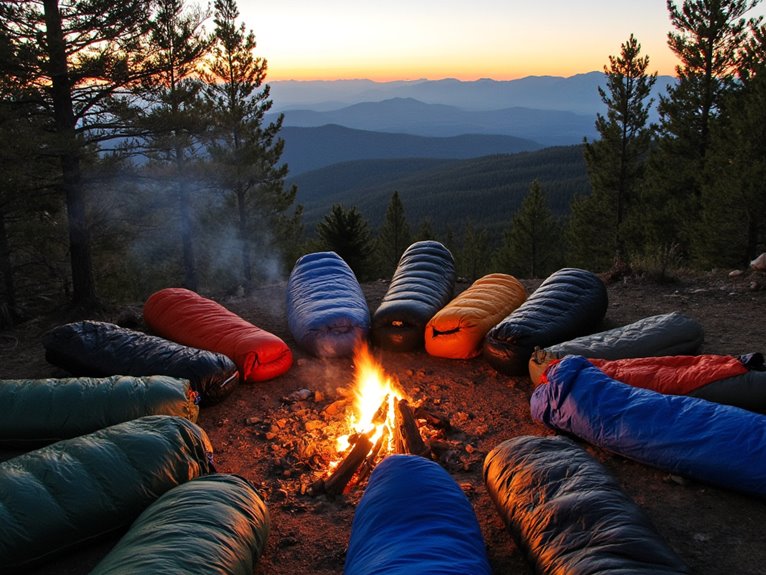10 Best Sleeping Bags for Hiking That’ll Keep You Warm All Night
I’ve tested sleeping bags from budget-friendly options to premium gear, and the top performers include the VENTURE 4TH Backpacking Sleeping bag at 3 pounds for 40-80°F conditions, the ECOOPRO ultralight at 1.7 pounds for warm weather, and the TETON Sports LEEF mummy bag offering three temperature ratings down to 0°F. Key factors include choosing ratings 10-15°F below expected lows, prioritizing synthetic insulation for wet conditions, and selecting mummy designs for peak warmth-to-weight ratios. The complete breakdown reveals specific performance data for each model.
We are supported by our audience. When you purchase through links on our site, we may earn an affiliate commission, at no extra cost for you. Learn more. Last update on 4th December 2025 / Images from Amazon Product Advertising API.
Notable Insights
- Choose mummy-shaped sleeping bags for superior warmth-to-weight ratios and better heat retention compared to rectangular designs.
- Select bags with synthetic insulation that maintains warmth when wet, or down insulation for lightweight warmth in dry conditions.
- Look for waterproof outer shells made from ripstop polyester or nylon to protect against moisture and tears.
- Match temperature ratings to your hiking conditions, adding 25-30 degrees to manufacturer ratings for actual comfort levels.
- Prioritize lightweight options under 4 pounds with compression sacks for easier transport during long hiking trips.
VENTURE 4TH Backpacking Sleeping Bag – Lightweight for Hiking & Camping
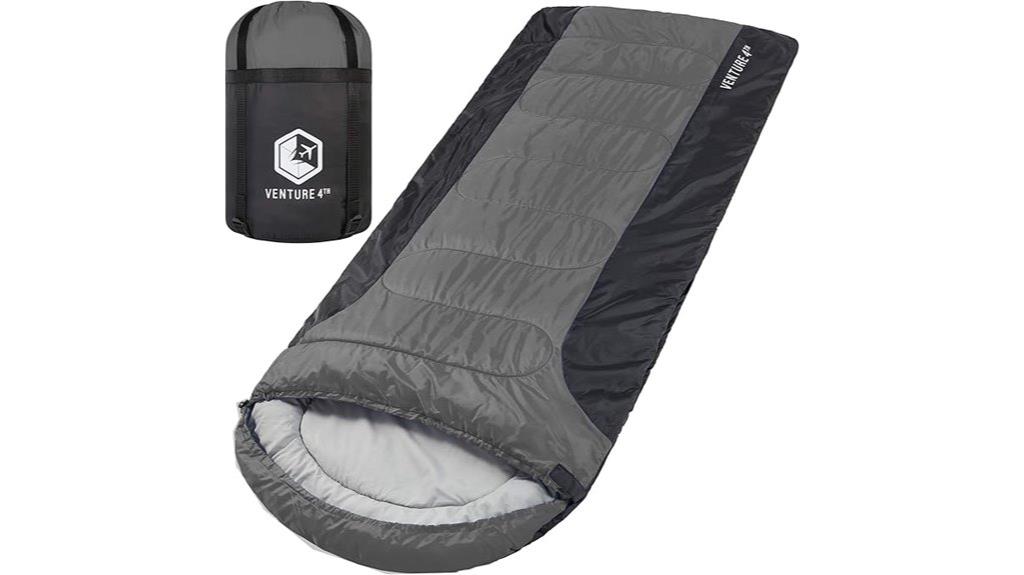
The VENTURE 4TH Backpacking Sleeping Bag targets hikers and campers who prioritize lightweight gear without sacrificing comfort in moderate weather conditions. This bag weighs just 3 pounds and measures 86.6 x 31.5 inches, fitting campers up to 5’11”. It’s ideal for temperatures between 40-80°F, though users report warmth down to 37°F. The durable polyester construction offers water resistance and easy cleaning. You’ll appreciate the spacious design that allows unrestricted movement while the soft inner material mimics a hotel comforter. The included compression sack enables compact storage for effortless transport on your hiking adventures.
Best For: Hikers and backpackers seeking a lightweight, comfortable sleeping bag for moderate weather conditions who value unrestricted movement and easy portability.
Pros:
- Lightweight at only 3 pounds with included compression sack for easy transport and storage
- Spacious design allows unrestricted movement with soft, hotel comforter-like inner material
- Lifetime replacement guarantee with responsive customer service and pre-shipping product testing
Cons:
- Quirky hood feature that users find problematic or awkward to use
- Zipper tends to get caught during operation, causing frustration during setup
- Limited to moderate temperatures (40-80°F optimal range) making it unsuitable for cold weather camping
FARLAND Sleeping Bags 30℉ for Adults with Compression Sack
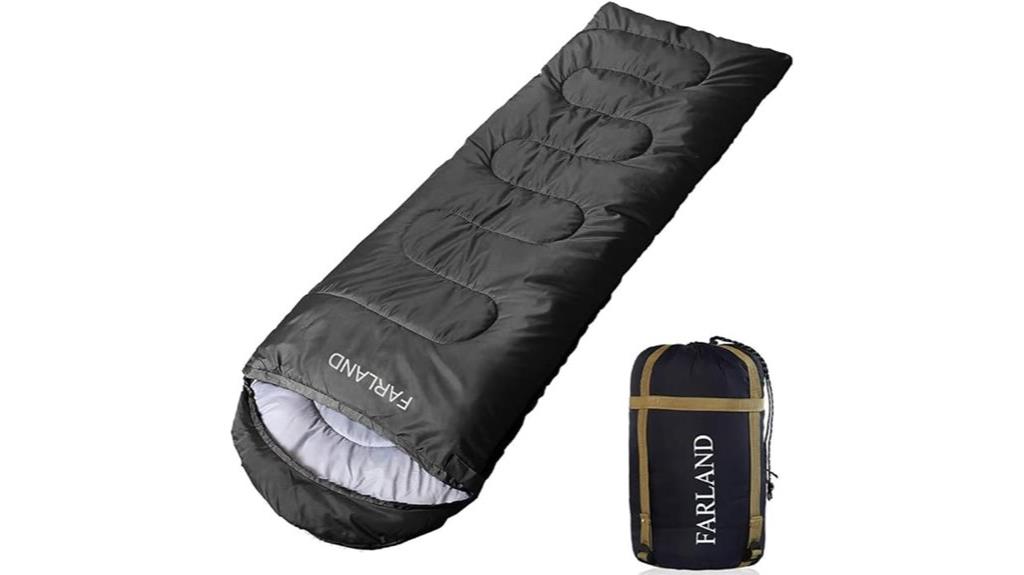
Budget-conscious adventurers seeking reliable warmth during three-season excursions will find the FARLAND Sleeping Bags 30℉ delivers essential performance without premium pricing. This bag handles temperatures from 20-62℉ effectively. You’ll appreciate the 290T nylon shell’s waterproof construction and polyester pongee lining. Choose between envelope (29.5 x 86.6 inches) or mummy (33.5 x 86.6 inches) configurations. The 400GSM polyester fill provides adequate insulation for most conditions. At 4.5 pounds, it’s reasonably portable with the included compression sack. Two-way zippers enable temperature regulation, while the internal pouch stores essentials. Customer reviews average 4.3 stars, though some report stitching durability concerns.
Best For: Budget-conscious campers and hikers who need reliable three-season warmth without spending premium prices on a sleeping bag.
Pros:
- Versatile temperature range (20-62℉) with waterproof 290T nylon construction suitable for various weather conditions
- Affordable pricing with useful features like compression sack, two-way zippers, and ability to zip two bags together
- Available in both envelope and mummy shapes to accommodate different sleeping preferences
Cons:
- Some durability concerns reported with stitching quality and stuff sack construction
- May not perform as well as advertised in extreme cold conditions without additional insulation
- At 4.5 pounds, it’s heavier than ultralight alternatives for serious backpackers
ECOOPRO Warm Weather Sleeping Bag – Portable, Waterproof & Lightweight
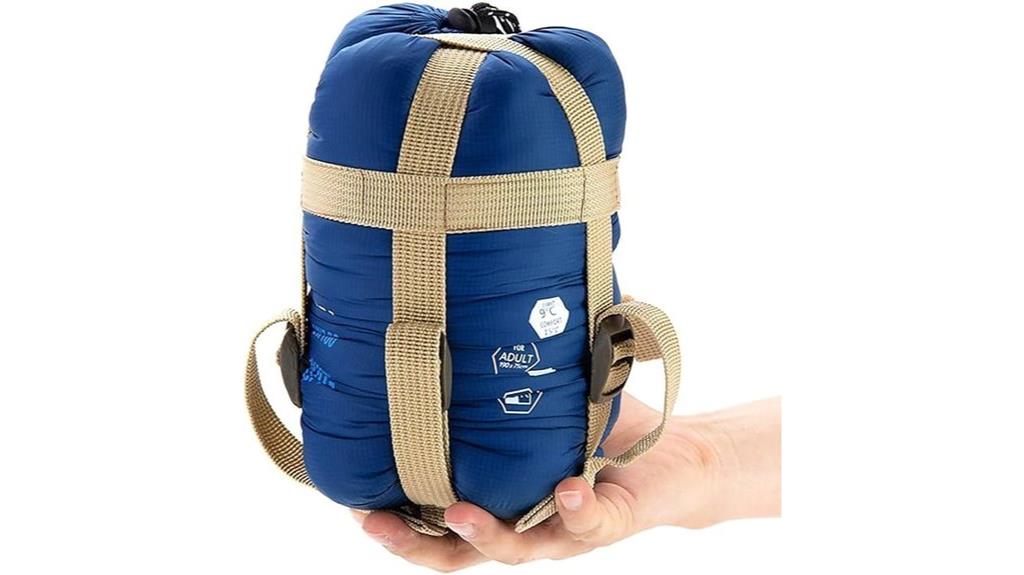
Warm weather hikers seeking a balance between comfort and portability will find the ECOOPRO Warm Weather Sleeping Bag delivers exactly what its name promises. You’ll appreciate its 83L x 30W dimensions and ultralight 1.7-pound weight. The envelope design accommodates temperatures between 55-60℉, making it perfect for summer backpacking trips.
The waterproof nylon exterior and breathable polyester lining provide essential weather protection while preventing overheating. You can compress it down to just 11 inches in height, saving valuable backpack space. With 8,468 customer ratings averaging 4.4 stars, this bag ranks #4 in camping sleeping bags. However, you shouldn’t rely on it for cold weather camping below 50℉ or heavy rainfall conditions.
Best For: Warm weather campers and backpackers who prioritize lightweight portability and need a sleeping bag for temperatures between 55-60℉.
Pros:
- Ultra-lightweight at only 1.7 pounds and compresses to just 11 inches for easy backpack storage
- Waterproof nylon exterior with breathable polyester lining prevents overheating in warm conditions
- High customer satisfaction with 4.4/5 stars from over 8,000 reviews and ranks #4 in camping sleeping bags
Cons:
- Limited temperature range makes it unsuitable for cold weather camping below 50℉
- Waterproofing only effective against light drizzle, not heavy rainfall
- Envelope design may feel snug for users with broader shoulders
TETON Sports LEEF Ultralight Mummy Sleeping Bag for Backpacking & Camping
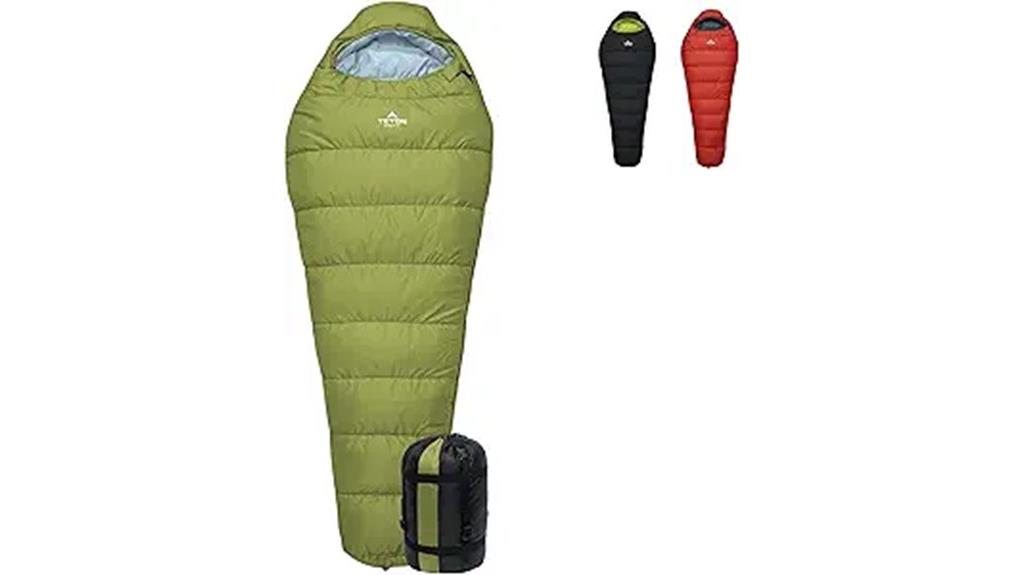
Backpackers seeking a reliable three-season sleeping bag that won’t break the bank will find exceptional value in the TETON Sports LEEF Ultralight Mummy Sleeping Bag. At 4.6 pounds and 87 x 30 x 3 inches, it offers three temperature ratings: 0°F, 20°F, and 30°F. The contoured mummy design maximizes warmth while preventing claustrophobia. PolarLite Micro Insulation and durable polyester construction provide consistent performance. However, add 25-30 degrees to stated temperature ratings for actual comfort levels. The dual-zipper ventilation system allows foot-level airflow adjustment. While it doesn’t compress enough for some backpack sleeping compartments, the included stuff sack and lifetime warranty make this an excellent value proposition.
Best For: Budget-conscious backpackers and campers who need a reliable three-season sleeping bag with good warmth-to-weight ratio and don’t mind slightly bulkier packing dimensions.
Pros:
- Excellent value with lifetime warranty and three temperature rating options (0°F, 20°F, 30°F)
- Contoured mummy design provides warmth without claustrophobia and includes dual-zipper ventilation system
- Lightweight at 4.6 pounds with durable polyester construction and PolarLite Micro Insulation
Cons:
- Temperature ratings run optimistic – need to add 25-30 degrees for actual comfort levels
- Too bulky to fit in many backpack sleeping compartments, requiring external packing
- Some air leakage through face opening may require blocking in colder conditions
Lightweight Waterproof Sleeping Bags for Adults Backpacking
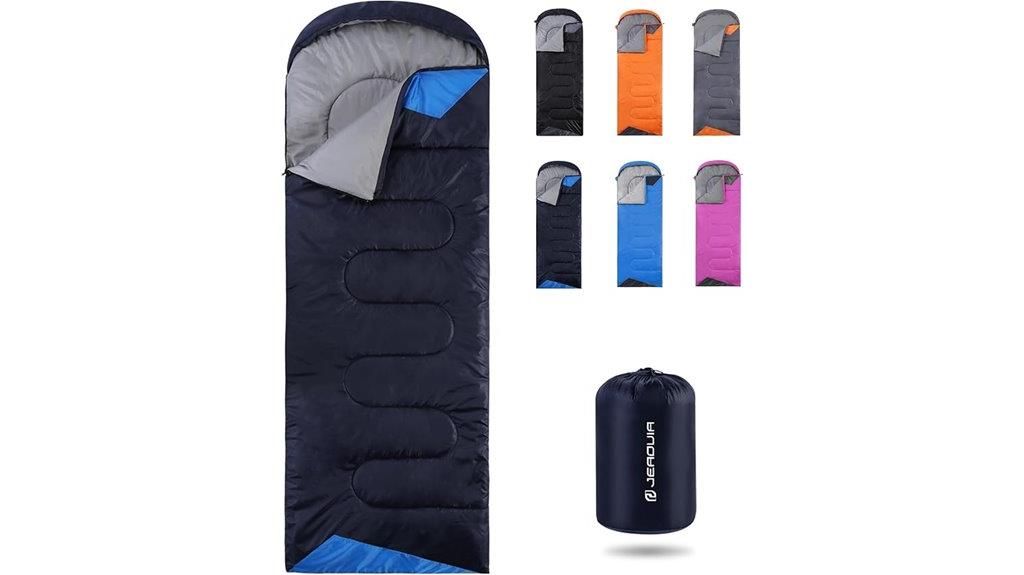
When you prioritize packability without sacrificing weatherproof protection, the Sleeping Bags for Adults Backpacking delivers essential performance for three-season adventures. This 3.3-pound bag compresses to just 7.9-14.2 inches, making it ideal for weight-conscious hikers. Its 100% polyester outer shell provides waterproof protection while maintaining breathability through the polyester pongee lining.
The bag’s 31.5 by 86.6-inch dimensions accommodate campers up to 5’11”. You’ll stay comfortable in temperatures ranging from 50℉-68℉, with recommended limits extending to 41℉-77℉. The drawstring hood retains heat efficiently, while the foot zipper allows airflow regulation. Hollow cotton filling provides adequate insulation without excessive bulk. With 9,942 customer ratings averaging 4.5 stars, this sleeping bag ranks #2 in camping gear.
Best For: Weight-conscious backpackers and casual campers who need a compact, waterproof sleeping bag for three-season use in moderate climates.
Pros:
- Excellent packability at 3.3 lbs with compression down to 7.9-14.2 inches for easy transport
- Waterproof polyester shell with breathable lining provides reliable weather protection
- Smart design features including drawstring hood and foot zipper for temperature regulation
Cons:
- Limited size accommodation only fits campers up to 5’11” which may be restrictive for taller users
- Temperature rating of 50℉-68℉ may not provide adequate warmth for colder conditions
- Some users report zipper durability issues that could affect long-term reliability
Teton 20F and 5F Degree Lightweight Mummy Sleeping Bag
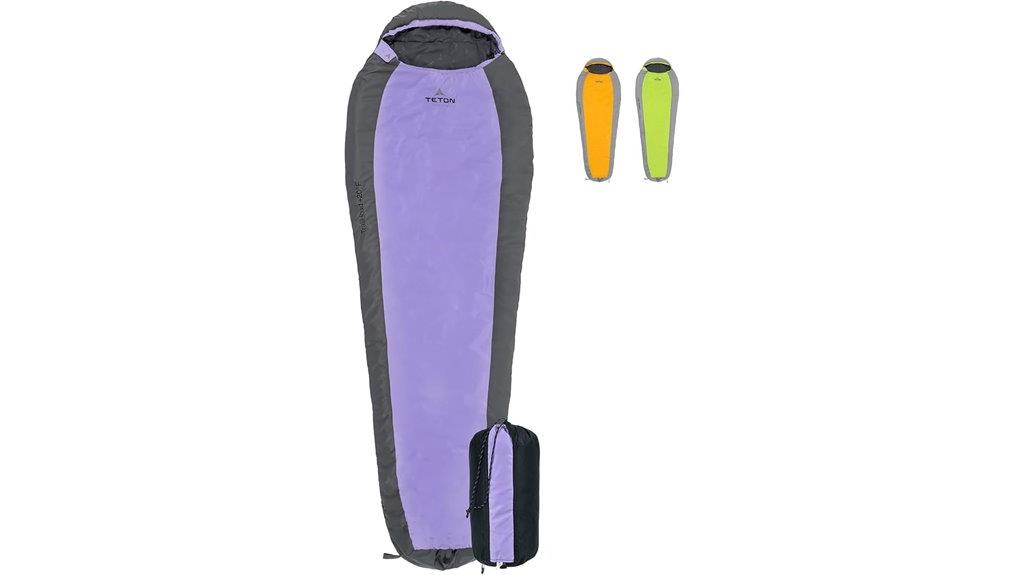
The TETON 20F and 5F Degree Lightweight Mummy Sleeping Bag delivers essential warmth for hikers who need reliable protection in cold conditions without the bulk. This microfiber construction weighs 8.2 pounds and measures 87 x 63 x 3 inches. You’ll get comfort ratings down to +2°C with limit ratings reaching -7°C.
The mummy hood design minimizes heat loss while zipper draft tubes prevent cold air infiltration. Body mapping technology concentrates insulation around your feet for ideal warmth retention. You can compress it into the included sack for easy transport.
The spacious footbox allows natural foot positioning during sleep. Anti-snag zippers won’t catch on fabric during nighttime adjustments. Store it uncompressed to maintain loft between trips.
Best For: Cold weather campers, backpackers, and hikers who need reliable warmth retention down to -7°C while prioritizing packability and comfort during extended outdoor trips.
Pros:
- Body mapping technology and spacious footbox provide targeted warmth and comfortable foot positioning during sleep
- Mummy hood design with zipper draft tubes effectively minimizes heat loss and prevents cold air infiltration
- Compressible design with included compression sack makes it practical for backpacking and hiking transport
Cons:
- At 8.2 pounds, it’s heavier than many ultralight alternatives for backpacking
- Some users report durability issues with the compression sack over time
- Cannot be machine washed, requiring more careful maintenance and cleaning procedures
SereneLife 0 Degree Mummy Sleeping Bag for Extreme Cold Camping

SereneLife’s 0 Degree Mummy Sleeping Bag targets extreme cold weather campers who need reliable warmth in harsh conditions. You’ll get a 60% cotton and 40% polyester blend with waterproof 210T polyester shell and soft pongee liner. The bag measures 86.6L x 33.5W inches, accommodating heights up to 7.22 feet while weighing 4.4 pounds.
Double-layer hollow cotton fill provides insulation down to 5-10°F. You’ll find an anti-snag zipper, built-in valuables pocket, and included compression sack with travel pillow. Customer feedback shows 4.3/5 stars from 301 ratings, with users confirming effectiveness around 40°F but questioning colder temperature performance.
Best For: Cold weather campers and outdoor enthusiasts who need a reliable, waterproof sleeping bag for temperatures around 40°F and above, particularly those who prioritize comfort features and don’t mind carrying extra weight.
Pros:
- Waterproof 210T polyester shell with soft pongee liner provides protection from moisture while maintaining comfort
- Includes useful accessories like compression sack, travel pillow, and built-in pocket for valuables
- Good customer satisfaction with 4.3/5 stars and proven effectiveness in moderate cold conditions around 40°F
Cons:
- At 4.4 pounds, it’s relatively heavy for backpacking and hiking compared to ultralight alternatives
- Users report zipper reliability issues that could affect long-term durability
- Temperature rating may be optimistic as customers question performance in truly extreme cold below 40°F
FARLAND Sleeping Bags 30℉ for Adults with Compression Sack
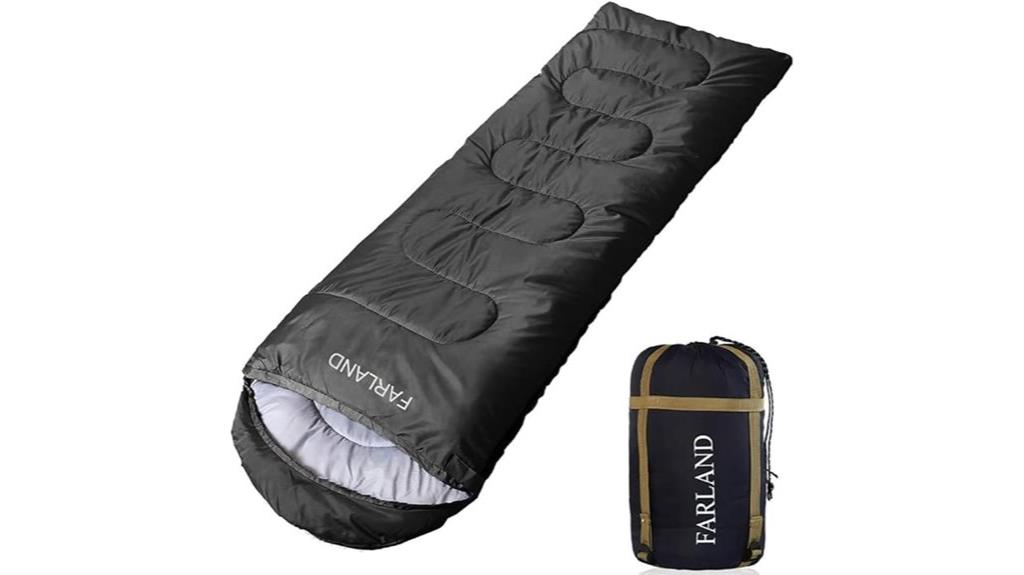
FARLAND’s 30℉ sleeping bag delivers essential three-season protection for hikers who prioritize versatility and packability over ultralight performance. You’ll get reliable warmth in temperatures from 20-62℉ with 400GSM polyester fill insulation. The 290T nylon shell provides waterproof protection while remaining breathable during active use.
Choose between envelope (29.5 x 86.6 inches) or mummy (33.5 x 86.6 inches) configurations based on your space preferences. At 4.5 pounds, it’s heavier than ultralight options but compensates with durability and thermal efficiency. The included compression sack reduces pack volume considerably. Two-way zippers enable temperature regulation, while the internal pocket secures valuables during sleep.
Best For: Three-season campers, hikers, and backpackers who need reliable warmth and durability without requiring ultralight gear for their outdoor adventures.
Pros:
- Versatile temperature range (20-62℉) with solid 400GSM polyester insulation for consistent warmth across three seasons
- Waterproof 290T nylon shell with breathable design and convenient features like two-way zippers and internal storage pocket
- Multiple configuration options with envelope and mummy shapes, plus ability to zip two bags together for couples or extra space
Cons:
- At 4.5 pounds, significantly heavier than ultralight alternatives, making it less ideal for long-distance backpacking
- Some quality control issues reported with stitching durability and stuff sack construction
- May not perform to stated temperature ratings in harsh conditions without additional insulation like a sleeping pad
Bessport Mummy Sleeping Bag for Adults Cold Weather (15-45℉)

Demanding hiking conditions require gear that performs when temperatures plummet, making the Bessport Mummy Sleeping Bag an ideal choice for outdoor enthusiasts who face cold-weather camping scenarios. This 3-4 season bag handles temperatures from 15-45℉ effectively. You’ll appreciate its 90.5-inch length and 31.4-inch width, accommodating adults up to 66 inches tall comfortably.
The bag weighs just 3.6 pounds. Its 210T ripstop polyester exterior repels water while resisting tears from rocks and branches. Inside, soft polyester taffeta provides comfort against your skin. Double SBS zippers prevent snagging during entry and exit.
Quilted construction and an insulated footbox retain heat efficiently. The drawstring hood seals warmth around your head. You’ll find the included stuff sack compresses everything into a manageable 14.5 x 11-inch package for transport.
Best For: Cold-weather campers and hikers who need a lightweight, packable sleeping bag for 3-4 season use in temperatures down to 15℉.
Pros:
- Lightweight at 3.6 pounds with excellent packability into a compact 14.5 x 11-inch stuff sack
- Durable 210T ripstop polyester exterior provides water resistance and protection from tears
- Effective heat retention with quilted construction, insulated footbox, and drawstring hood
Cons:
- Temperature ratings may be inconsistent or overly optimistic based on some customer feedback
- Limited to adults 66 inches tall or shorter due to sizing constraints
- Performance varies significantly depending on individual warmth preferences and layering
Ultralight Warm Weather Sleeping Bag – Portable, Waterproof & Compact
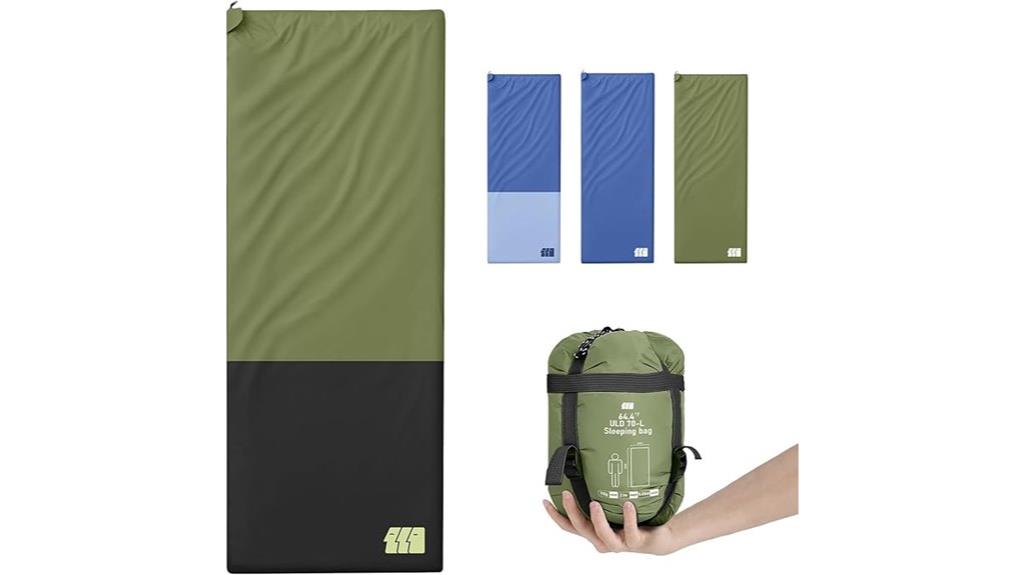
When you’re tackling warm-weather hiking adventures where every ounce counts, TANSTRIDER’s Ultralight Warm Weather Sleeping Bag delivers exceptional portability without sacrificing comfort. At just 1.6 pounds, this rectangular bag measures 82.7L x 31.5W inches and performs superbly in 50-70°F conditions. The durable nylon exterior and breathable washed cotton lining provide reliable weather protection while maintaining airflow.
You’ll appreciate the two-way zipper system that connects with another bag or converts into a blanket. Foot zippers enhance ventilation during warmer nights. The included compression bag reduces packed dimensions to 13.39 x 7.05 x 4.53 inches, maximizing your backpack space efficiency for extended hiking trips.
Best For: Ultralight backpackers and hikers who need a compact, versatile sleeping solution for warm weather camping in temperatures between 50-70°F.
Pros:
- Extremely lightweight at 1.6 pounds with excellent packability (compresses to 13.39 x 7.05 x 4.53 inches)
- Versatile two-way zipper system allows connection with another bag or conversion to blanket/quilt
- Durable nylon exterior with waterproof protection and breathable cotton lining for comfort
Cons:
- Limited temperature range (50-70°F) restricts use to warm weather conditions only
- Rectangular shape may be less thermally efficient than mummy-style bags
- At 31.5 inches wide, it may feel cramped for larger individuals compared to standard sleeping bags
Factors to Consider When Choosing Sleeping Bag Hiking
I’ll guide you through the essential factors that determine whether a sleeping bag meets your hiking needs. Your choice impacts every aspect of your outdoor experience, from sleep quality to pack weight and trail performance. Let’s examine the five critical considerations: temperature rating requirements, weight and packability, shape and size, insulation material types, and durability and construction.
Temperature Rating Requirements
Understanding temperature ratings represents the most critical factor in selecting a hiking sleeping bag that’ll keep you comfortable throughout the night. I recommend choosing a rating 10-15 degrees lower than the forecasted minimum temperature for best warmth. Most quality sleeping bags feature three distinct ratings: comfort, limit, and extreme. The comfort rating provides your best benchmark for restful sleep.
Temperature ranges vary considerably between models. Some perform effectively within 20-62℉ spans, making them ideal for cool-weather hiking. Lightweight bags designed for cold conditions may handle sub-freezing temperatures, while warm-weather options only function effectively above 50℉.
Don’t rely solely on manufacturer specifications. I suggest reading user reviews to understand real-world performance, as personal warmth preferences and sleeping habits affect how each bag performs at stated temperature thresholds.
Weight and Packability
Although warmth matters most, weight and packability determine whether you’ll actually enjoy carrying your sleeping bag on multi-day hikes. I recommend targeting sleeping bags weighing 1.6 to 4.5 pounds for ideal load management. Your bag should compress to 7.9 to 14.2 inches in length when packed.
Look for models that include compression sacks. These accessories reduce volume considerably, making backpack organization easier. The key lies in balancing lightweight fabric with effective insulation materials.
Weight directly impacts your hiking endurance over long distances. Every ounce counts when you’re carrying gear for multiple days. Packability affects how efficiently you can organize your backpack’s internal space. A properly compressed sleeping bag leaves room for essential gear while maintaining your pack’s center of gravity for comfortable carrying.
Shape and Size
When selecting a sleeping bag for hiking, shape and size decisions directly impact your warmth retention, comfort, and carrying efficiency. I recommend mummy-shaped bags for hiking because they provide superior warmth-to-weight ratios compared to rectangular options. The tapered design reduces dead air space while cutting overall weight.
Size selection requires careful attention to your height and girth measurements. Most bags accommodate users up to 5’11” in regular sizes, with widths ranging from 29.5 to 33.5 inches. I suggest measuring your shoulders, hips, and feet to ascertain proper fit. Choose from short, regular, or long lengths based on your height.
Proper sizing maximizes insulation efficiency. Too large creates cold spots; too small restricts movement and compresses insulation, reducing thermal performance.
Insulation Material Types
The foundation of any sleeping bag’s thermal performance lies in its insulation material, which determines warmth retention, weight, packability, and moisture resistance characteristics. I’ll break down the three primary insulation types you’ll encounter.
Synthetic insulation uses polyester fibers that maintain warmth when wet. It’s budget-friendly and performs consistently in humid conditions. However, it’s heavier and less compressible than alternatives.
Down insulation offers superior warmth-to-weight ratios and compresses to remarkably small sizes. It loses thermal properties when wet unless treated with DWR coatings. Premium down costs more but delivers exceptional performance.
Hybrid insulation combines both materials strategically. Manufacturers place synthetic fill in moisture-prone areas while using down elsewhere.
Temperature ratings correlate directly with insulation type and quantity, affecting your comfort in specific conditions.
Durability and Construction
Beyond selecting the right insulation, your sleeping bag’s longevity depends on robust construction materials and thoughtful design features. I recommend choosing bags made from ripstop polyester or nylon fabrics. These materials resist tears and punctures during rugged use.
You’ll want waterproof outer shells that protect against moisture infiltration. Check zipper quality carefully—anti-snag designs prevent frustrating failures in cold conditions. Reinforced stitching at stress points extends bag lifespan remarkably.
Compression capability matters for durability. Quality bags compress to manageable sizes without damaging internal components. This protects insulation integrity during transport and storage.
High-grade synthetic or down insulation maintains structural integrity through repeated compression cycles. Poor insulation breaks down quickly, creating cold spots. Quality fills retain loft and warming properties across hundreds of uses, making them worthwhile investments.
Waterproof and Weather Resistance
Weather protection separates reliable sleeping bags from gear that’ll leave you shivering in soggy misery. I recommend prioritizing waterproof nylon outer shells with measurable ratings that withstand light rain and moisture penetration. The outer cover’s waterproof rating directly determines your bag’s effectiveness in wet conditions.
Breathable linings become essential for high humidity scenarios. They prevent condensation buildup that’ll compromise insulation performance during damp nights. I always check temperature ratings alongside waterproof features, since wet conditions dramatically reduce thermal efficiency when temperatures drop.
Look for enhanced weather resistance features like drawstring hoods and zipper draft tubes. These components minimize heat loss through air infiltration. Draft tubes create sealed barriers along zipper lines, while adjustable hoods eliminate thermal escape points around your head and shoulders.
Price and Value Balance
Smart spending on hiking sleeping bags requires balancing upfront costs against long-term performance value. I recommend evaluating the weight-to-cost ratio first. Heavier bags offer more insulation but increase transport costs and fatigue during extended hikes.
Temperature ratings directly correlate with price. A bag rated to 15°F typically costs 40-60% more than one rated to 32°F. However, this investment pays off in harsh conditions where hypothermia risks increase considerably.
I always check manufacturer warranties before purchasing. Quality brands offer 3-5 year warranties, indicating confidence in their construction. Customer reviews reveal actual durability versus marketing claims.
Consider your intended use carefully. A $300 down bag that lasts 10 seasons provides better value than a $150 synthetic bag requiring replacement after three seasons. Calculate cost-per-night based on expected usage frequency.
On a final note
I’ve analyzed the top-performing sleeping bags across temperature ranges from 15℉ to warm weather conditions. Each model offers distinct advantages: ultralight designs for weight-conscious backpackers, compression capabilities for space efficiency, and waterproof materials for wet conditions. Your choice depends on specific factors like temperature rating, weight tolerance, and pack size requirements. Consider your hiking environment, personal warmth preferences, and gear capacity. These recommendations provide reliable insulation and durability for extended wilderness adventures.

